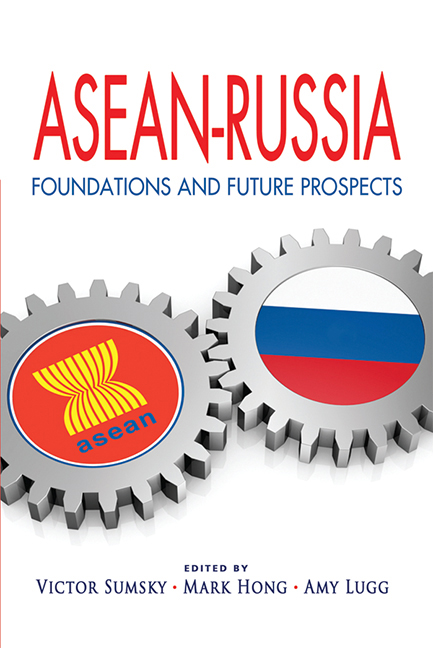Book contents
- Frontmatter
- Contents
- Foreword
- Preface
- About the Contributors
- Keynote Address
- Opening Remarks
- Keynote Address
- Introduction: Russia and the ASEAN Member States: Political and Economic Cooperation in Progress
- SECTION I WISEMEN'S VIEWS
- SECTION II GEOPOLITICS
- Russia in Southeast Asia: A New “Asian Moment”?
- ASEAN-Russia Military Ties: Reconfiguring Relations
- The Enlargement of the East Asia Summit: The Reasons and Implications of Bringing Russia In
- Russia's Entry into ASEM: Not Just a Courtesy Call?
- Russia-India-China: Acting in Concert in Southeast Asia?
- The South China Sea Issue: A View from Russia
- Southeast Asia and Russia: Forging a New Regional Architecture
- Russia-ASEAN Relations: An Indian Perspective
- SECTION III BILATERAL RELATIONS
- SECTION IV Business and Economics
- SECTION V CULTURE AND EDUCATION
- EPILOGUE
- Index
Southeast Asia and Russia: Forging a New Regional Architecture
from SECTION II - GEOPOLITICS
Published online by Cambridge University Press: 21 October 2015
- Frontmatter
- Contents
- Foreword
- Preface
- About the Contributors
- Keynote Address
- Opening Remarks
- Keynote Address
- Introduction: Russia and the ASEAN Member States: Political and Economic Cooperation in Progress
- SECTION I WISEMEN'S VIEWS
- SECTION II GEOPOLITICS
- Russia in Southeast Asia: A New “Asian Moment”?
- ASEAN-Russia Military Ties: Reconfiguring Relations
- The Enlargement of the East Asia Summit: The Reasons and Implications of Bringing Russia In
- Russia's Entry into ASEM: Not Just a Courtesy Call?
- Russia-India-China: Acting in Concert in Southeast Asia?
- The South China Sea Issue: A View from Russia
- Southeast Asia and Russia: Forging a New Regional Architecture
- Russia-ASEAN Relations: An Indian Perspective
- SECTION III BILATERAL RELATIONS
- SECTION IV Business and Economics
- SECTION V CULTURE AND EDUCATION
- EPILOGUE
- Index
Summary
ABSTRACT
Global political changes and regional geopolitical accommodations have had a profound impact on Southeast Asia-Russia relations. The various states of Southeast Asia have had different experiences in their relationship with Russia, especially under the Soviet Union; there was an “unwritten” separation of Southeast Asia into those states that had close ties and those that did not, irrespective of diplomatic status. Political ideology and the expected level of beneficial outcomes were the causal reasons — accounting positively or negatively towards the shared perception of both regions. With the disintegration of the Soviet Union and the renewed interest of Southeast Asian states towards a reconstituted Russian federation, both parties were ready to explore mutual ties. Thus the stage was set, not only for increased bilateral relations, but also for the collective relationship between the Association of Southeast Asian Nations (ASEAN) and Russia. While not yet as active and integrated as ASEAN's relations with the other Dialogue Partners, the ASEAN-Russia links are gradually gaining momentum as indicated by increased political, economic and social interactions.
THE PAST ON THE PRESENT — INFLUENCES ON SOUTHEAST ASIA AND RUSSIA
The long absence of any form of significant relationship between most of the states of Southeast Asia and Russia was the result of mutually prevalent factors of geography, ignorance, suspicion and the general lack of leaders’ incentives to forge closer ties. The past, perhaps as far back as the beginnings of the western colonial period in Southeast Asia in the sixteenth century, has not registered significant encounters with Russia. Fast forward to the period as represented by the twentieth century as characterized by the Russian Revolution and the rising Soviet Union in a Cold War entanglement — that only added to the drift between the two geographical areas, except for those in Southeast Asia, who were inspired by the ideals of Marxism. Thus a few of the states looked to the Soviet Union as a political model and thus support, while other non communist states exercised partiality from a potentially “dangerous” power that might subvert the entrenched local political systems.
- Type
- Chapter
- Information
- ASEAN-RussiaFoundations and Future Prospects, pp. 110 - 123Publisher: ISEAS–Yusof Ishak InstitutePrint publication year: 2012



